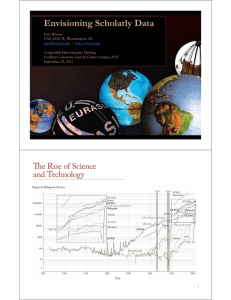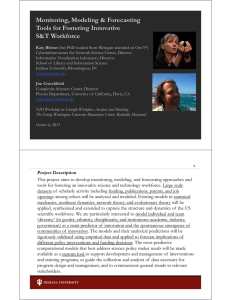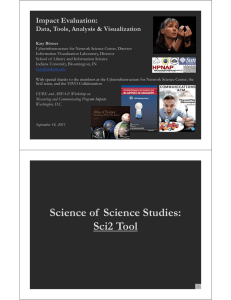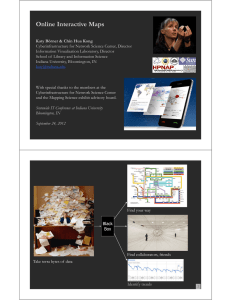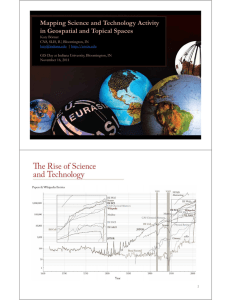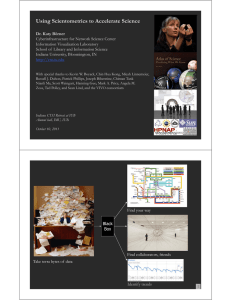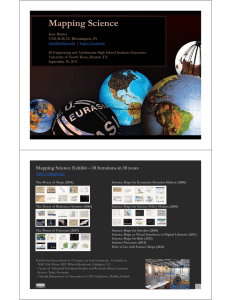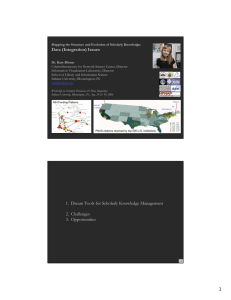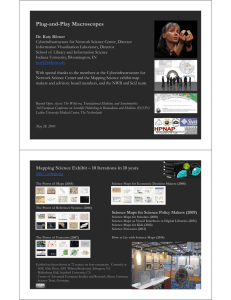Analysis and Visualization of Science
advertisement
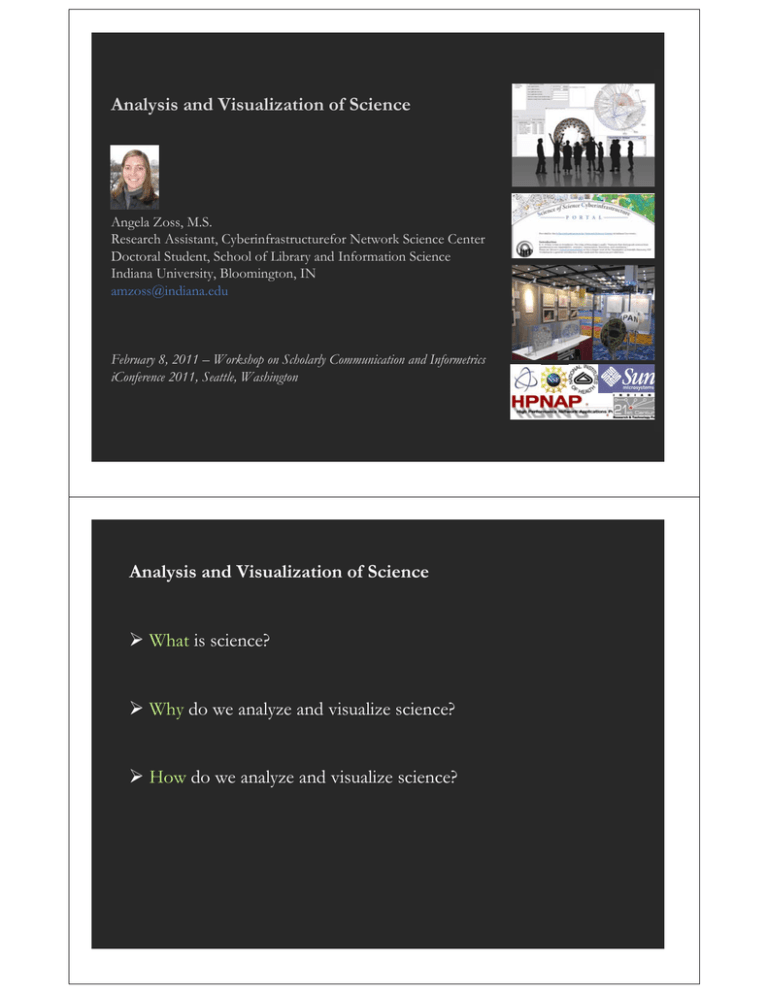
Analysis and Visualization of Science Angela Zoss, M.S. Research Assistant, Cyberinfrastructurefor Network Science Center Doctoral Student, School of Library and Information Science Indiana University, Bloomington, IN amzoss@indiana.edu February 8, 2011 – Workshop on Scholarly Communication and Informetrics iConference 2011, Seattle, Washington Analysis and Visualization of Science What is science? Why do we analyze and visualize science? How do we analyze and visualize science? Conceptualizing Science Authors are mortal. Papers are immortal. Monsters = ‘the unknown’ or voids. Impact of funding on science (yellow). Good and bad years. Hypothetical Model of the Evolution of Science - Daniel Zeller - 2007 Atlas of Science - Katy Borner - 2010 Science as accumulation of knowledge. “Scholarly brick laying”. Standing on the shoulders of giants. Densely knit communities. The importance of weak links. Hypothetical Model of the Evolution of Science - Daniel Zeller - 2007 Maps of Science: Forecasting Large Trends in Science - Richard Klavans, Kevin Boyack - 2007 In Terms of Geography - Andre Skupin - 2005 Areas of science are tube shaped. Hypothetical Model of the Evolution of Science - Daniel Zeller - 2007 Atlas of Science - Katy Borner - 2010 HistCiteTM Visualization of DNA Development - Eugene Garfield, Elisha Hardy, Katy Borner, Ludmila Pollock, Jan Witkowski- 2006 Crust of science can represent “funding” or “usage”. Hypothetical Model of the Evolution of Science - Daniel Zeller - 2007 A Clickstream Map of Science – Bollen, Johan, Herbert Van de Sompel, AricHagberg, Luis M.A. Bettencourt, Ryan Chute, Marko A. Rodriquez, Lyudmila Balakireva - 2008 This drawing attempts to shows the “structure” of science. Many are interested to understand the “dynamics” of science. Hypothetical Model of the Evolution of Science - Daniel Zeller - 2007 Council for Chemical Research - Chemical R&D Powers the U.S. Innovation Engine. Washington, DC. Courtesy of the Council for Chemical Research - 2009 Why Map Science? Cartographic maps of physical places have guided mankind’s explorations for centuries. They enabled the discovery of new worlds while also marking territories inhabited by the unknown. Without maps, we would be lost. Domain maps of abstract semantic spaces aim to serve today’s explorers navigating the world of science. These maps are generated through a scientific analysis of large-scale scholarly datasets in an effort to connect and make sense of the bits and pieces of knowledge they contain. They can be used to identify objectively major research areas, experts, institutions, collections, grants, papers, journals, and ideas in a domain of interest. Science maps can provide overviews of “allof-science” or of a specific area. They can show homogeneity vs. heterogeneity, cause and effect, and relative speed. They allow us to track the emergence, evolution, and disappearance of topics and help to identify the most promising areas of research. Information Needs for Science Map User Groups Advantages for Funding Agencies Supports monitoring of (long-term) money flow and research developments, evaluation of funding strategies for different programs, decisions on project durations, funding patterns. Staff resources can be used for scientific program development, to identify areas for future development, and the stimulation of new research areas. Advantages for Researchers Easy access to research results, relevant funding programs and their success rates, potential collaborators, competitors, related projects/publications (research push). More time for research and teaching. Advantages for Industry Fast and easy access to major results, experts, etc. Can influence the direction of research by entering information on needed technologies (industry-pull). Advantages for Publishers Unique interface to their data. Publicly funded development of databases and their interlinkage. For Society Dramatically improved access to scientific knowledge and expertise. Analysis and Visualization of Science Type of Analysis vs. Scale of Level of Analysis Micro/Individual (1-100 records) Meso/Local (101–10,000 records) Macro/Global (10,000 < records) Statistical Analysis/Profiling Individual person and their expertise profiles Larger labs, centers, universities, research domains, or states All of NSF, all of USA, all of science. Temporal Analysis (When) Funding portfolio of one individual Mapping topic bursts in 20-years of PNAS 113 Years of physics Research Geospatial Analysis (Where) Career trajectory of one individual Mapping a states intellectual landscape PNAS publications Topical Analysis (What) Base knowledge from which one grant draws. Knowledge flows in Chemistry research VxOrd/Topic maps of NIH funding Network Analysis (With Whom?) NSF Co-PI network of one individual Co-author network NSF’s core competency Type of Analysis vs. Scale of Level of Analysis Micro/Individual (1-100 records) Meso/Local (101–10,000 records) Macro/Global (10,000 < records) Statistical Analysis/Profiling Individual person and their expertise profiles Larger labs, centers, universities, research domains, or states All of NSF, all of USA, all of science. Temporal Analysis (When) Funding portfolio of one individual Mapping topic bursts in 20-years of PNAS 113 Years of physics Research Geospatial Analysis (Where) Career trajectory of one individual Mapping a states intellectual landscape PNAS publications Topical Analysis (What) Base knowledge from which one grant draws. Knowledge flows in Chemistry research VxOrd/Topic maps of NIH funding Network Analysis (With Whom?) NSF Co-PI network of one individual Co-author network NSF’s core competency Process of Computational Scientometrics Data Extraction Searches •ISI •INSPEC •Eng Index •Medline •ResearchIndex •Patents •etc. Broadening •By citation •By terms Unit of Analysis Common Choices •Journal •Document •Author •Term Measures Layout (often one code does both similarity and ordination steps) Similarity Ordination Counts/Frequencies •Atributes (e.g., terms) •Author citations •Co-citations •By year Scalar (unit by unit matrix) •Direct citation •Co-citation •Combined linkage •Co-word/co-term •Co-classification Thresholds •By counts Vector (unit by attribute matrix) •Vector space model (words/terms) •Latent Semantic Analysis (words/terms) incl. Singular Value Decomp (SVD) Dimensionality Reduction: •Eigenvector/Eigenvalue solutions •Factor Analysis (FA) and Principal Components Analysis (PCA) •Multi-dimensional scaling (MDS) •LSA •Pathfinder networks (PFNet) •Self-organizing maps (SOM) incl. SOM, ET-maps, etc. Correlation (if desired) •Pearson’s R on any of above Display Interaction •Browse •Pan •Zoom •Filter •Query •Detail on demand Analysis Cluster analysis Scalar •Triangulation •Force-directed placement (FDP) Börner, Katy, Chen, Chaomei, and Boyack, Kevin. (2003) Visualizing Knowledge Domains. In Blaise Cronin (Ed.), Annual Review of Information Science & Technology, Volume 37, Medford, NJ: Information Today, Inc./American Society for Information Science and Technology, chapter 5, pp. 179-255. Computational Scientometrics: Studying Science by Scientific Means Börner, Katy, Chen, Chaomei, and Boyack, Kevin. (2003). Visualizing Knowledge Domains. In Blaise Cronin (Ed.), Annual Review of Information Science & Technology, Medford, NJ: Information Today, Inc./American Society for Information Science and Technology, Volume 37, Chapter 5, pp. 179-255. http://ivl.slis.indiana.edu/km/pub/2003-borner-arist.pdf Shiffrin, Richard M. and Börner, Katy (Eds.) (2004). Mapping Knowledge Domains.Proceedings of the National Academy of Sciences of the United States of America, 101(Suppl_1). http://www.pnas.org/content/vol101/suppl_1/ Börner, Katy, Sanyal, Soma and Vespignani, Alessandro (2007). Network Science. In Blaise Cronin (Ed.), Annual Review of Information Science & Technology, Information Today, Inc./American Society for Information Science and Technology, Medford, NJ, Volume 41, Chapter 12, pp. 537-607. http://ivl.slis.indiana.edu/km/pub/2007-borner-arist.pdf Places & Spaces: Mapping Science exhibit, see also http://scimaps.org. Börner. Katy. (2010). Atlas of Science: Visualizing What We Know. MIT Press. http://scimaps.org/atlas Börner, Katy. (March 2011). Plug-and-Play Macroscopes.Communications of the ACM. Science of Science Cyberinfrastructure Overview What cyberinfrastructure will be required to measure, model, analyze, and communicate scholarly data and, ultimately, scientific progress? This talk presents our efforts to create a science of science cyberinfrastructure that supports: • Data access and federation via the Scholarly Database, http://sdb.slis.indiana.edu, • Data preprocessing, modeling, analysis, and visualization using plug-and-play cyberinfrastructures such as theSci2 Tool, http://sci2.cns.iu.edu, and • Communication of science to a general audience via the Mapping Science Exhibit at http://scimaps.org. The following demos should be particularly interesting for those interested to • Map their very own domain of research, • Test and compare data federation, mining, visualization algorithms on large scale datasets, • Use advanced network science algorithms in their own research. http://sci.slis.indiana.edu Scholarly Database(http://sdb.cns.iu.edu) The Scholarly Database at Indiana University provides free access to 25,000,000 papers, patents, and grants. Since March 2009, users can also download networks, e .g., co-author, co-investigator, co-inventor, patent citation, and tables for burst analysis. Sci2 Tool for Science of Science(http://sci2.cns.iu.edu) • Explicitly designed for SoS research and practice, well documented, easy to use. • Empowers many to run common studies while making it easy for exports to perform novel research. • Advanced algorithms, effective visualizations, and many (standard) workflows. • Supports micro-level documentation and replication of studies. • Is open source—anybody can review and extend the code, or use it for commercial purposes. Sci2 Tool for Science of Science Research and Practice Sci2 Tool for Science of Science Research and Practice Supported Input file formats: • GraphML (*.xml or *.graphml) • XGMML (*.xml) • Pajek .NET (*.net) &Pajek .Matrix (*.mat) • NWB (*.nwb) • TreeML (*.xml) • Edge list (*.edge) • CSV (*.csv) • ISI (*.isi) • Scopus (*.scopus) • NSF (*.nsf) • Bibtex (*.bib) • Endnote (*.enw) Output file formats: GraphML (*.xml or *.graphml) Pajek .MAT (*.mat) Pajek .NET (*.net) NWB (*.nwb) XGMML (*.xml) CSV (*.csv) http://sci2.wiki.cns.iu.edu/2.3+Data+Formats Network Extraction Sample paper network (left) and four different network types derived from it (right). From ISI files, about 30 different networks can be extracted. Sci2 Tool Plugins that render into Postscript files: Sci Maps Geo Maps Horizontal Time Graphs Börner, Katy, Huang, Weixia (Bonnie), Linnemeier, Micah, Duhon, Russell Jackson, Phillips, Patrick, Ma, Nianli, Zoss, Angela, Guo, Hanning & Price, Mark. (2009). Rete-Netzwerk-Red: Analyzing and Visualizing Scholarly Networks Using the Scholarly Database and the Network Workbench Tool. Proceedings of ISSI 2009: 12th International Conference on Scientometrics and Informetrics, Rio de Janeiro, Brazil, July 14-17 . Vol. 2, pp. 619-630. Exemplary Analyses and Visualizations Individual Level A. Loading ISI files of major network science researchers, extracting, analyzing and visualizing paper-citation networks and co-author networks (p. 54-65) B. Loading NSF datasets with currently active NSF funding for 3 researchers at Indiana U (p. 49-53) Institution Level C. Indiana U, Cornell U, and Michigan U, extracting, and comparing Co-PI networks (p. 65-69) Scientific Field Level D. Extracting co-author networks, patent-citation networks, and detecting bursts in SDB data (p. 77-85) All papers, maps, cyberinfrastructures, talks, press are linked from http://cns.iu.edu
